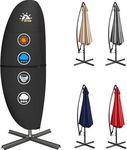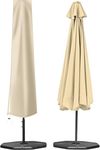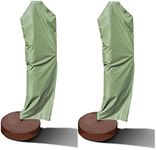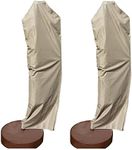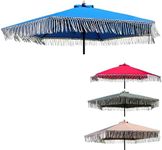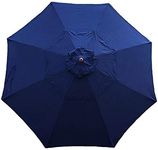Buying Guide for the Best Outdoor Umbrella Covers
Choosing the right outdoor umbrella cover is essential to protect your umbrella from the elements and extend its lifespan. A good cover will shield your umbrella from rain, sun, wind, and dust, ensuring it stays in good condition for years to come. When selecting an outdoor umbrella cover, consider the following key specifications to find the best fit for your needs.MaterialThe material of the umbrella cover is crucial because it determines the level of protection it offers. Common materials include polyester, vinyl, and canvas. Polyester is lightweight and resistant to water and UV rays, making it a popular choice. Vinyl is highly durable and waterproof but can be heavier. Canvas is breathable and sturdy but may require additional waterproofing. Choose a material based on the climate in your area and the level of protection you need. For example, if you live in a rainy area, a waterproof material like vinyl might be best, while a UV-resistant polyester cover could be ideal for sunny regions.
SizeThe size of the umbrella cover is important to ensure a proper fit. Measure the height and width of your umbrella when it is closed to determine the correct size. Covers come in various sizes, so it's essential to find one that fits snugly without being too tight or too loose. A well-fitting cover will provide better protection and prevent the cover from blowing off in strong winds. If you have a standard-sized umbrella, you can find covers labeled for specific sizes, but for custom or larger umbrellas, you may need to look for adjustable or oversized covers.
WaterproofingWaterproofing is a key feature to look for in an outdoor umbrella cover, especially if you live in an area with frequent rain. A waterproof cover will prevent water from seeping through and damaging the umbrella fabric and frame. Look for covers with sealed seams and water-resistant coatings to ensure maximum protection. If you live in a dry climate, waterproofing may be less critical, but it can still be beneficial to protect against unexpected showers.
UV ProtectionUV protection is important to prevent the umbrella fabric from fading and deteriorating due to prolonged sun exposure. Covers with UV-resistant coatings or materials will block harmful UV rays and keep your umbrella looking new for longer. If your umbrella is exposed to direct sunlight for extended periods, investing in a cover with high UV protection is essential. For areas with less intense sunlight, a standard UV-resistant cover should suffice.
Ease of UseEase of use refers to how simple it is to put on and take off the umbrella cover. Features like zippers, drawstrings, and Velcro straps can make the process more convenient. A cover that is easy to use will encourage you to cover your umbrella regularly, providing consistent protection. Consider your physical ability and how often you plan to use the cover when evaluating ease of use. If you need to cover and uncover the umbrella frequently, look for a cover with user-friendly features.
VentilationVentilation is an important feature to prevent mold and mildew from forming on your umbrella. Covers with built-in vents allow air to circulate, reducing moisture buildup. This is especially important in humid climates where mold and mildew are more likely to develop. If you live in a dry area, ventilation may be less of a concern, but it can still help keep your umbrella fresh and odor-free.
Color and DesignWhile not as critical as other specifications, the color and design of the umbrella cover can be important for aesthetic reasons. Choose a color that complements your outdoor decor and a design that you find visually appealing. Darker colors may show less dirt and wear, while lighter colors can reflect sunlight and keep the umbrella cooler. Ultimately, the choice of color and design is a personal preference, but it can enhance the overall look of your outdoor space.




